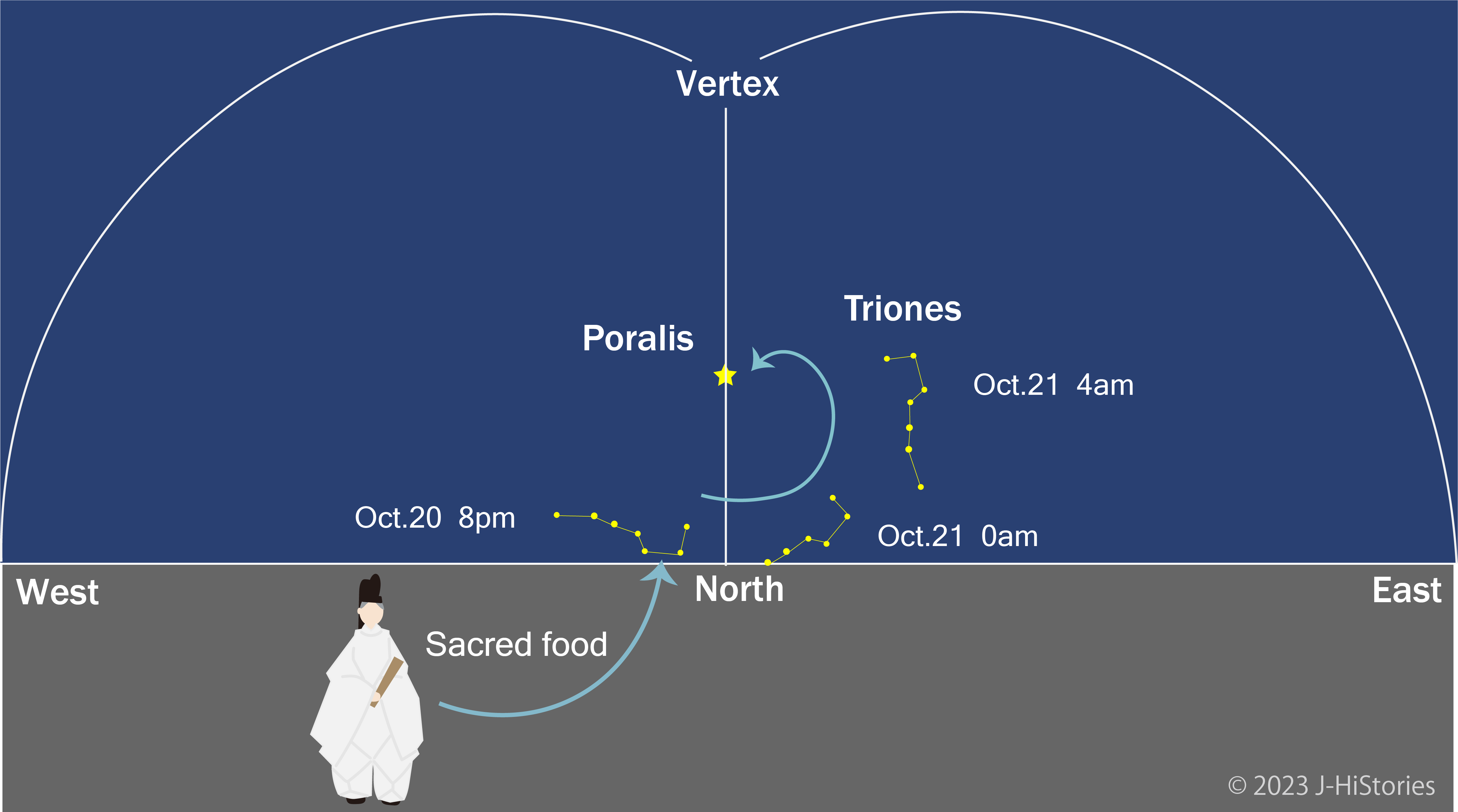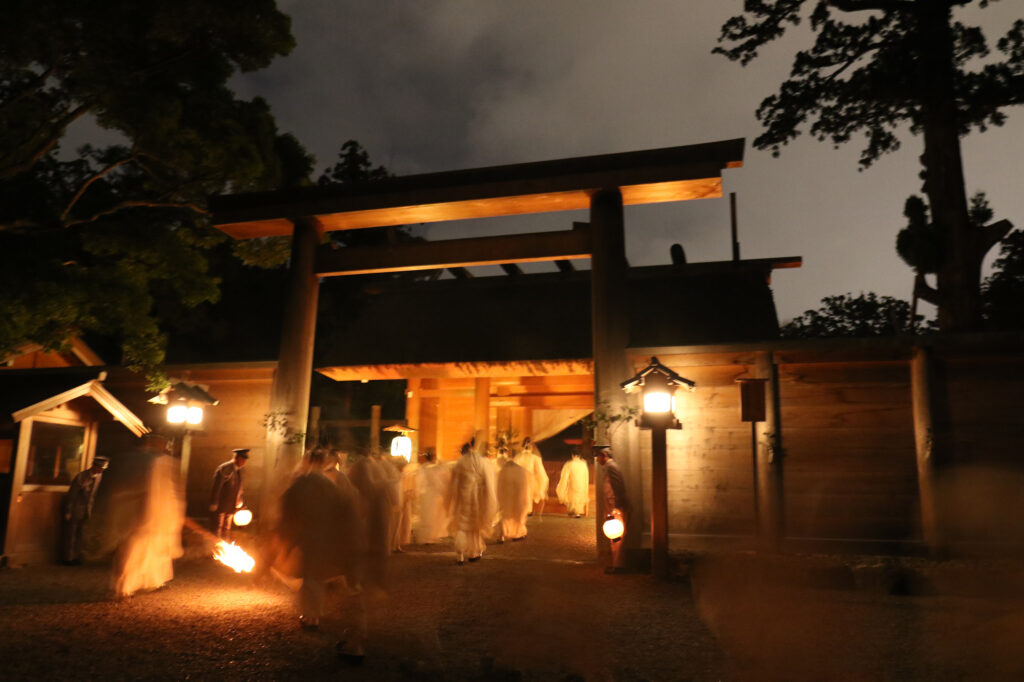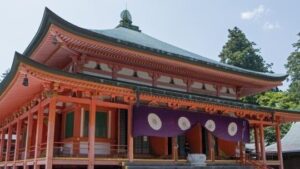Ise Jingu Shrine, Geku First and Then Naiku
Ise Jingu Shinto Shrine (伊勢神宮), officially called “Jingu” consists of 125 Shinto shrines. Crossing the Uji Bridge over the Isuzu River at the entrance of a main shrine, “Kotaijingu” (Naiku), you are in a sacred world where the deities dwell. As you walk the pea gravel approach along the giant cedar trees, you may feel the awe of the sanctuary. 1,500 rituals are conducted annually to pray for the prosperity and peace of the Imperial Family, people, and the world. The two main shrines, “Kotaijingu” (known well as Naiku) is dedicated to Amaterasu-Omikami, the ancestral deity of the present Imperial family, and “Toyo’uke-daijingu” (known well as Geku) is dedicated to Toyo’uke-no-Omikami deity. Toyo’uke-no-Okami was summoned to Jingu from Tanba province, a northern area of Kyoto prefecture, to provide companionship and serve sacred food to Amaterasu-Omikami according to ”Kojiki (Records of Ancient Matters)” and ”Nihonshoki (The Chronicles of Japan)”. From ancient days, "Geku first and then Naiku" is the common custom to pray to Jingu's deities. Are there any reasons for this custom? It is not clear yet. But it seemed to be based on Inyo Gogyo theory to provide crops (offerings) to Amaterasu-Omikami through Toyo’uke-no-Omikami. Let’s see its story.

Triones Circles 360 Degrees Per Day Around Polaris
Upon the fall of Baekje (one of the ancient countries in the Korean peninsula) after being attacked by Shilla (another country in the Korean peninsula) and the Tang dynasty in 660, a large number of Baekje’s refugees fled to Japan. Some of them brought the Yin-Yang Wu-Hsing theory. According to it, "Taiitsu (Polaris)” governs the world (or north, south, east, and west and also up and down) by riding a specific vehicle or Triones in space. Polaris does not move at all, instead, it stays in the same position in the northern sky. On the other hand, Triones circles 360 degrees per day around Polaris and its ladle moves in twelve orientations per year.
Prayers Reach Toyo’uke-no-Omikami, Then Amaterasu-Omikami
Knowing Inyo Gogyo’s theory, the 40th Emperor Tenmu (? -686, 天武天皇) evolved it and attempted to deify the position of Emperor. For this, he transformed the Ise Jingu Shrine by integrating the heavens. That is, synchronizes his ancestral deity, Amaterasu-Omikami with Taiitsu (Polaris) and invites Toyo’uke-no-Omikami from Tanba province as Amaterasu’s specific vehicle (Triones). Kojiki and Nihonshoki introduce that “Amaterasu-Omikami says that it's difficult for me to stay at a spot, implying the necessity of my vehicle. It’s difficult for me to eat alone, implying the necessity of the deity of the crop.” Jingu’s most important Kanname-sai festival is held on October 15th-17th starting at 10 pm. At that time Triones is positioned on the northwest horizon and its ladle faces upwards onto the north, Taiitsu within reach. Shinto priests devote the Shinkoku (first crop of the year) to Triones (Toyo’uke-no-Omikami). Then Toyo’uke-no-Omikami devotes it to Taiitsu (Amaterasu-Omikami). This is one possible reason why it’s best to pray at “Geku first and then, Naiku”, otherwise, prayers do not reach Amaterasu-Omikami. (Reference:「隠された神々(Hidden Kami)」ISBN978-4-309-41330-3, Author=a folklorist, Hiroko Yoshino) [Note: This is NOT an official statement of Ise-Jingu. Now, the Kanname-sai festival begins at 10:00 p.m.]

Three Venerable and Important "Sansetsu" Festivals

(@神宮司庁/ Jingushicho : Jingu Administration Office)
The 'Sansetsu" three festivals (the above-mentioned Kanname-sai festival in October and Tsukinami festivals in June and December) are particularly venerable and important to the Jingu of the approximately 1,500 festivals held throughout the year. In the darkness of purity, offerings of new grain rice, rice cakes, and sacred sake, as well as other food from the sea and mountains, are served and offered twice, at 10 pm and 2 am to deities. Then Shinto priests pray for the prosperity of the imperial family and nation, a good harvest, and the peace of the people.
Shikinen Sengu Ritual
This Shikinen Sengu (Periodical Renewal Festival) was initiated by Emperor Temmu, and the first Sengu was held in 690 during the reign of his wife and Reigning Emperor Jito (645-703, 持統天皇). It has been the most venerable festival at the shrine for approximately 1,300 years, although it was suspended once during the Muromachi period (1336-1573). The main sanctuaries of Naiku, Geku, and other buildings are renewed every 20 years. In addition, the sacred adornments and treasures dedicated to the deities are made from the same materials, and construction methods according to ancient ceremonies as much as possible. Every ritual continues to be performed without having changed. In this eternal change, the deities have been rejuvenated and have been the guardians of the nation, the people, and the imperial family.
Jingu Has Proven The Coexistence With Nature
Since a large amount of wood is used for the Sengu, tireless efforts are being made to plant trees in the palace forests near the shrine in anticipation of several hundred years. In this forest, about 2,800 species of animals, 140 species of birds, and 850 species of plants have been identified, giving us the rich bounty of nature. The prayers of the ancient people to the supernatural power of "Kami" are the same as our prayers today. Please enjoy Ise Jingu Shrine while feeling the awe of the sanctuary. Please don't forget to visit Geku first and then Naiku.
Recommendations to visit
- Access from Nagoya: 1 hour and 20 minutes from Kintetsu Nagoya Station, then get off at "Iseshi Station (伊勢市)". A 5-minute walk to Geku. A 10-minute bus #51 or #55 to Naiku.
- Access from Kyoto: 2 hours and 10 minutes from Kintetsu Kyoto Station, then get off at "Iseshi Station (伊勢市)". A 5-minute walk to Geku. A 10-minute bus #51 or #55 to Naiku.



One thought on “Ise Jingu Shrine, Geku First and Then Naiku”
Comments are closed.